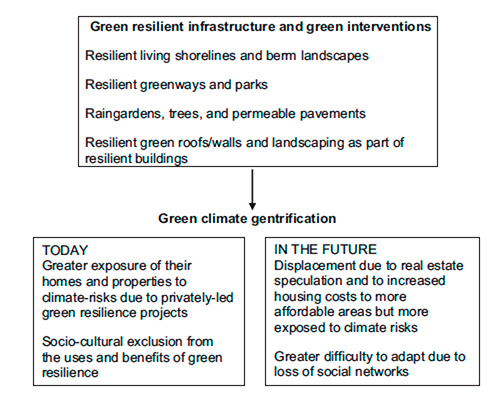My recent research led in collaboration with researchers from the BCNUEJ lab and colleagues from the United States highlights that urban climate resilience planning produces a new type of urban climate injustice: green climate gentrification.
Our studies find that low-income, working class, and minority residents are among the social groups most likely to experience residential and social displacement—in the short and mid-term—from green climate infrastructure. Although green roofs, resilient parks and greenways, rain gardens, or detention basins and canals are increasingly hailed as win-win infrastructure to protect cities against climate change impacts, we argue that such interventions overlook or minimize negative impacts for socially vulnerable groups. At the same time, those projects sell the image of a green and resilient 21stcentury city to investors, real estate developers, and new sustainability-class residents who are those most benefiting from green interventions.
The research we conducted in Boston (on greening and resilience planning in East Boston) and Philadelphia (on green stormwater management infrastructure throughout the city) reveals that vulnerable populations—many of whom have already been exposed to hazardous conditions in their neighborhoods—now stand to benefit least from greening initiatives. For instance, in Philaldephia, we find a negative association between the siting of green infrastructure and increased minority population, and a strong positive association between green infrastructure siting, gentrification, and reduced minority and low-income population. In Boston, we find that the Boston real estate industry is building resilient properties for elites and displacing lower-income residents in East Boston, while advocating for the City of Boston to create new protection zones for future investments.
In sum, improvement of marginalized neighborhoods through green infrastructure may cause these vulnerable populations to lose their neighborhoods altogether.
Reference
